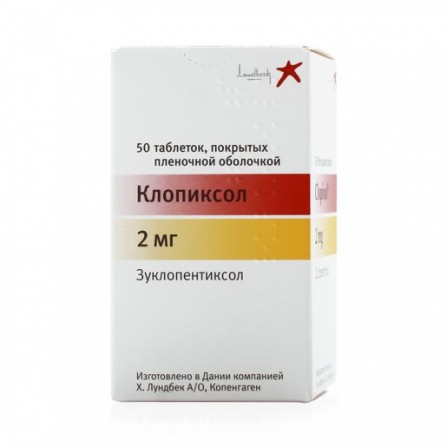Clopixol coated pills 2mg bottle N50
Condition: New product
994 Items
Rating:
Be the first to write a review!

More info
Active ingredients
Zuclopentixol
Release form
Pills
Composition
Zuclopentixol dihydrochloride 2.364 mg, which corresponds to the content of zuclopentixol 2 mg; Excipients: potato starch - 22.2 mg, lactose monohydrate - 17.4 mg, microcrystalline cellulose - 9 mg, copovidone - 3 mg, glycerol 85% - 1.2 mg, talc - 4.2 mg , hydrogenated castor oil - 0.48 mg, magnesium stearate - 0.42 mg.; The composition of the shell: opadry pink (hypromellose 5 - 1.37 mg, macrogol 6000 - 0.275 mg, titanium dioxide (E171) - 0.447 mg, ferric oxide red (E172) - 0.011 mg).
Pharmacological effect
Antipsychotic (neuroleptic), a derivative of thioxanthene. It is believed that the antipsychotic action of zuclopentixol is due to the blockade of dopamine receptors in the CNS. Thioxanthene derivatives have a high affinity for dopamine D1 and D2 receptors.; Zuclopentixol causes a fast, transient, dose-dependent sedation, before the development of an antipsychotic action.; Unlike with zuclopentixol hydrochloride, zuclopentixol acetate has a longer duration of action - 2-3 days , and zuclopentixol decanoate is a depot form and its effect lasts for 2-4 weeks.
Pharmacokinetics
After oral administration, zuclopentixol is rapidly absorbed from the gastrointestinal tract. Cmax in plasma is reached after 3-6 hours. Biological T1 / 2 is about 24 hours; After i / m administration as a depot form, Cmax in blood plasma is reached after 36 hours. 3 days after the injection, the level is approximately 1 / 3 from the maximum.; Zuclopentixol is distributed in the body, with higher concentrations in the liver, lungs, intestines and kidneys, lower - in the heart, spleen, brain and blood.; Vd is 20 l / kg. Plasma protein binding 98%. Penetrates through the placental barrier, excreted in breast milk.; Zuclopentixol is metabolized by sulphonic acidification, N-dealkylation and glucuronization. Metabolites do not have psychopharmacological activity.; It is derived mainly from the feces as an unchanged substance and N-dealkylated metabolite.
Indications
For oral administration: the manic phase of a manic-depressive psychosis, mental retardation in conjunction with psychomotor agitation, agitation and other behavioral disorders; senile dementia with paranoid ideas, confusion, disorientation, behavioral disorders. For intramuscular administration: initial treatment of acute psychoses,manic states and chronic psychosis in the acute phase. For intramuscular administration of the depot form: maintenance therapy for schizophrenia and paranoid psychosis.
Contraindications
Acute overdose of barbiturates, opioid receptor agonists, acute alcohol intoxication, coma, hypersensitivity to zuclopentyxol.
Use during pregnancy and lactation
Use during pregnancy and lactation is not recommended.; Low concentrations of Zuclopentixol are found in breast milk.
Dosage and administration
The dose, frequency and duration of use depend on the evidence, the dosage form used and the regimen. For oral administration, the initial dose may be 2–20 mg / day; if necessary, a gradual increase in the dose up to 75 mg / day or more is possible. For a intramuscular injection a single dose is 50-150 mg, if repeated injections are necessary, the interval between them should be 2-3 days. For the intramuscular injection depot forms a single dose of 200-750 mg, the frequency of administration is 1-4 weeks and is determined by the clinical situation.
Side effects
On the part of the central nervous system: dizziness, drowsiness (especially when using the drug in high doses and at the beginning of treatment), the development of extrapyramidal disorders (mainly at the beginning of treatment), accommodation disorder; rarely, with long-term therapy, tardive dyskinesia. On the part of the cardiovascular system: tachycardia, orthostatic hypotension; On the part of the digestive system: dry mouth, constipation, rarely - slight transient changes in liver tests. .
Overdose
Symptoms: drowsiness, coma, extrapyramidal disorders, convulsions, arterial hypotension, shock, hyper or hypothermia are possible. Treatment: if the drug is taken orally, it is necessary to wash the stomach as soon as possible, the use of a sorbent is recommended. In the future, conduct symptomatic and supportive therapy. Measures should be taken to support the activity of the respiratory and cardiovascular systems. Do not use epinephrine (adrenaline), because this can lead to a further decrease in blood pressure. Spasms can be stopped by diazepam, and extrapyramidal symptoms biperidenom.
Interaction with other drugs
When used simultaneously with drugs that have a depressant effect on the central nervous system, with ethanol, means for anesthesia, their inhibitory effect on the central nervous system is potentiated, the action of the means for anesthesia is potentiated. development of ZNS with simultaneous use with clorazepat.; With simultaneous use, it is possible to reduce the effects of levodopa and adrenergic agents.; With simultaneous use uu with lithium carbonate possible increased side effects zuclopenthixol;. In an application with metoclopramide, piperazine increases the risk of extrapyramidal symptoms.
special instructions
Zuclopentixol is not used in patients with neuroleptic intolerance for oral administration, as well as in patients with Parkinson's disease. With extreme caution used in patients with convulsive syndrome, chronic hepatitis and cardiovascular diseases. With long-term use, careful monitoring of the patient's condition is necessary. It should be borne in mind that the use of neuroleptics is a rare, but possible complication with a fatal outcome, is the development of NNS. In such cases, the use of antipsychotics should be immediately discontinued and emergency symptomatic therapy should be initiated.; Antiparkinsonian drugs should be prescribed during treatment with zuclopentixol only when indicated and not used prophylactically.; Influence on ability to drive motor transport and control of mechanisms; to avoid activities that require high concentration and rapid psychomotor reactions.



